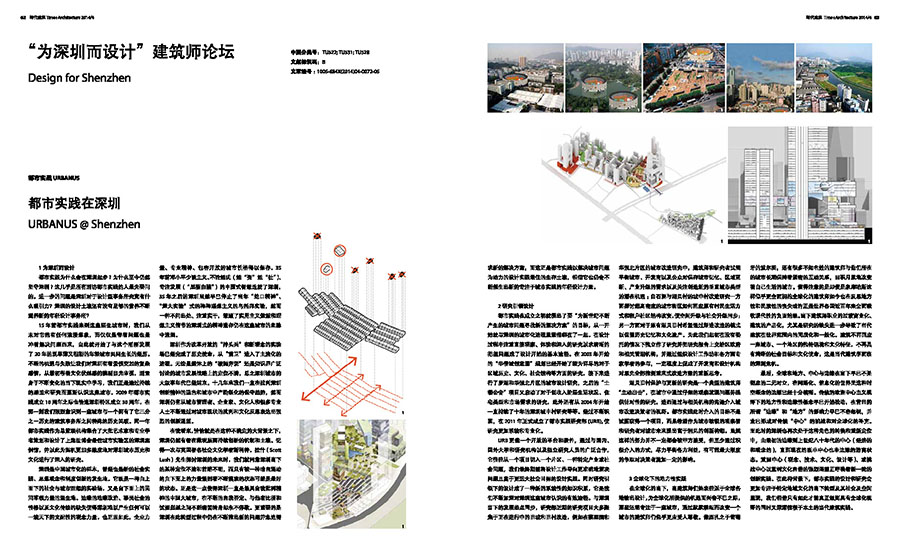URBANUS / MENG Yan
T+A 2014(4)60-61

Design for Shenzhen
Why did Shenzhen become the place where URBANUS established its first office? What is the reason that the company still stays on in this city? These are the most commonly asked questions by people who first visit the URBANUS office there. Further questions include: What is the attraction of this city to design-oriented firms? Is there sufficient nutrition in Shenzhen’s design soil that will continue supporting young design offices?
Fifteen years ago when we first arrived at Shenzhen, our expectation and imagination of this city was nothing romantic—we came with questions; we came for questions. At that point, Shenzhen was a young city that had just undergone two decades of vulnerable but extensive development. URBANUS was then founded to grow with city. Initially, we took a critical stance toward the city, with our cultural superiority. After experiencing numerous opportunities and failures, we learnt to adapt ourselves to the ever changing reality. Over the course of forming a love-hate relationship with this city, we understand it better and better through our continuous researching and constructing efforts. In 2009, URBANUS embraced its 10th anniversary, which also marked the 30th anniversary of the Shenzhen SEZ’s establishment. The coincidence reveals the unique historical tie between a city and an architectural design firm which shares one third of the city’s history. The same year, URBANUS, as the chief curator, summoned a legion of artists and professional scholars to organize and design the Shenzhen Case Pavilion at UBPA (Urban Best Practice Area) of Shanghai Expo, seeing it as an opportunity to carry out multi-dimensional, in-depth research on Shenzhen’s history and culture.
Shenzhen, a demonstration of China’s urbanization as well as the place where new social practices, ideologies and institutional innovations took place, is not only a top-down pilot site for realizing social and urban dreams, but also a bottom-up spot that breeds private initiatives. Its marginalized geopolitics, migrant communities, and the absence of traditional culture together have made it difficult for any single idea to achieve dominance over this city. Therefore, entrepreneurship, professionalism, and the open and inclusive urban characteristic are preserved. Shenzhen credits its early torrid growth to the Chinese wisdom embedded in policies introduced by Deng Xiaoping 35 years ago; the policies do not give priority to “–ism”s (stereotype principles), or “systems” (socialism or capitalism), but with a sole focus on development (“It doesn’t matter whether a cat is white or black, as long as it catches mice.”). Today, although Shenzhen has been away from the past various idealistic utopian experiments, such as the “Shekou Spirit” and the “Shenzhen University Experiment,” the city still maintains its unique spiritual artifacts—fairness, experimentalism, pragmatism, and idealism.
Shenzhen has fulfilled its mission as the bellwether of reform and of the opening-up policy, as well as being the pilot site for new ideas; it starts the transformation process from “vanguard” into mainstream. Whether evidenced by the media that says the city has been “abandoned,” or by the discussion among scholars about the its unclear positioning of urban development strategy, it has become clear that Shenzhen’s grand narrative age has ended. Over the past decade, we have been criticizing Shenzhen’s fading creativity and the conservative trend of gentrification. Meanwhile, there are urban managers, entrepreneurs, cultured people and many professionals who convey their strong desire for innovation through continuous criticism on the city’s status quo and the introspection of culture.
From my own viewpoint, it is such uncertainties that cultivate an environment in which Shenzhen is capable of maintaining its innovative mechanism and creative soil, at the micro level. As I recall, at a discussion about the future of Shenzhen with Mr. Scott Lush, a famous sociocultural scholar from the UK, we agreed that Shenzhen was currently facing the uncertain positioning of its future development; also, driven by the emerging bottom-up force, the city is always in a state of constant exploration—which is probably the best state for it. That is also the reason why Shenzhen has been observing self-criticism more closely than other cities in China: it never stops criticizing itself, comparing itself with and trying to surpass others. More critically, Shenzhen is a city that never stops raising new questions and seeking out new solutions over the course of its transitional process, which provides URBANUS, a design practice dedicated to solving urban problems, and other such firms that with exactly what it needs to grow.
Research-Led Design
When URBANUS was first established, it identified its goal as “search for new solutions to urban problems generated in the new century,” which was intricately tied to Shenzhen’s urbanization. The first thing we do when designing is to clearly identify the problem through direct observation, experience and thorough research. We carried out a detailed research for the “OCT LOFT” project commenced in 2003, on regional history, culture, social structure and so on. We also conducted the urban design research on Luohu and Huaqiangbei precinct, and another research initiative on lifestyle, residential typology and market demand of the low-income class for the “Urban Tulou” project. Moreover, for more than a decade we have conducted on-going research on the urban village phenomenon in Shenzhen. As a result of the increasing number of research projects, we created URBANUS Research Bureau (URB) in 2011 with the hope to systemize and professionalize our research.
URB tends to be a plug-in or an open platform where independent researchers from domestic and international universities and research institutions can work together on a particular project deemed as an entry point into understanding a precinct, a particular industry, or social problems. The ultimate goal of our design is to devise more workable solutions with profound social implications. Meanwhile, the research-led design transforms into a systematic collection of knowledge that opens up accesses for us to better understand the city. Keeping abreast of the newest development of Shenzhen, URB’s recent research projects concentrate on the ongoing redevelopment of old towns and villages. For instance, in the research on precinct redevelopment in Caiwuwei and Huaqiangbei, architects and researchers attempted to reach the optimal balance of interests among the city, the developer, and the public in terms of urban memories, regional regeneration, and the demand for industrial upgrade; meanwhile, they concern about the potential of creating new vertical urban typologies. Another example would be the research on urban village redevelopment in Baishizhou Village and Hubei Village. On the one hand, we studied how a hyper-dense mega block can respond to villagers’ original lifestyle as well as to the change in the tenant community structure, therefore synchronizing special upgrade with social upgrade; on the other hand, we hoped to save the old Hubei Village through a gradual redevelopment model that preserves historical memories and cultural artifacts. For these reasons, we launched independent research without being commissioned and submitted the research report to the district government and relevant management institutions. Then we invited specialists from multiple disciplines and organized design workshops that, in part, led developers and design institutions to rethink about the original redevelopment proposal which advocated a tabula rasa strategy.
The research on the preservation and regeneration of Hubei Village is a prime example of architects “taking the initiative.” Carefully peering into the city, we reveal problems, perform targeted research, and communicate with relevant institutions to intervene into the perspective of the decision makers. The motivation of our intervention is not about obtaining any project, but rather to set forth an in-depth and creative conception for the city as an incisive urban observant and researcher. Although active intervention and balancing of interests might not be fully accepted by clients, it is very likely that such efforts will sway the decision makers at some point.
A Glocal Design Practice
In the context of globalization, architects today are keen on travelling around the world to export their design. It seems that when the world is excited about the opportunities derived from globalization, the architects who stick to one city and quietly make a difference to that city is more respectable—such as Alvaro Siza who is based in Oporto, and many other unknown architects who keep a long-term, intimate, and interactive relationship with the cities they grow with and gradually make a difference to the cities. It is worth mentioning that, nowadays, even the internationalized big names such as Rem Koolhas also start to rethink about the loss of locality and ethnicity incurred from the recent centuries of uncritical assimilation of modernity. The over-commercialization of the occupation of architect, the commoditization of architectural design, and especially the destitution of research, collectively result in the world-wide homogenization and generalization of contemporary architecture. Architecture is no longer the reflection of a city’s or a region’s features; nor does it carry clear social objectives or cultural missions—contemporary architecture is facing such a severe crisis.
Lastly, neither “global/local” nor “central/marginal” represent a strictly binary opposition, because the boundary between the two opposites today is becoming blurred in the web-oriented, information-intensive world. The original definition of localism and marginalism under the traditional Eurocentric ideology have been altered, as the increasing influence of the “marginal” and the “local” is posing a challenge to the “central” and supplementing the globalization. Under such circumstances, Shenzhen is in the middle of a role shift—from initially the marginal state to becoming the center (in terms of economy and new ideas) in the 1980s, and to the current indefinite state where it is regarded as neither central nor marginal. Whether it is the desire of going back to the center (in terms of ideas, technologies, culture, design, and so forth), or the ambition to restore the cultural confidence by challenging the center, Shenzhen is desperately calling for a new wave of innovative practice. Give such a context, URBANUS’ design and research will increase the focus on local culture when it comes to ongoing transitions, and will be more devoted to social and spatial presentation. We firmly believe that this is the key for an architectural design firm to become internationally aware while stay deeply-rooted in local practice.
